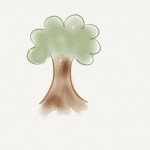Learning Journeys Stemming from Art
Having time to draw and paint has put me on a path to have so many learning journeys. Art is representation of the literal, of the abstract, of the everyday, of the past and the present. Whether I'm creating it or observing it, art in any form makes me think, question and wonder. This became particularly clear to me when I was in Prospect Park a few weeks ago, attempting to capture an old tree using my drawing pad and colored pencils. As I began to draw I found myself scrutinizing every detail of the tree and asking myself - what does this tree really look like? Because so often, I feel like the drawing of a tree is minimized to something like this:

However, because I was interested in capturing it more realistically, I rapidly glanced back and forth between the tree and my drawing pad, struggling withe amount of detail. This included things like:
- the trunk and the heavy branches don’t have any foliage, only the smaller branches do
- the bark is more charcoal than brown and so are all the other trees that my eye can see
- the tree trunk splits off into five major branches and then countless number of lighter branches, which then break off into smaller branches, which is where all the leaves are located
- this might be an oak because of it’s thick and dark bark with deep rivets, reminds me of the trees in our backyard growing up
- there’s a plaque under this tree dedicated to Teddy Roosevelt from the Boy Scouts in 1919
It got me thinking again about what might happen if students were given a chance to use drawing, painting or even qualitative observation as the entry point to new content. What might happen if a student was asked to draw something and then write down any questions or thoughts they might have about the object. Now, what if you were in a park, a historical part of town or in the school courtyard? What questions might this prompt? In what conversations or journeys could a student partake?In my example, it led me to these questions: what kind of tree is this? does it belong to the oak family? what classifies something as an oak tree? why do some branches grow large and others stay lean, or do they all get to that point over time? This particular tree also could prompt a discussion on Teddy Roosevelt and why the local Boy Scout troop commemorated the tree to him. It might lead to a discussion on Teddy's relevance as both a President but as also someone who deeply cared about national parks. A follow-up might be a trip (if one were so lucky as to live this close) to Sagamore Hill, his home that is now a museum. There are many avenues that can be traveled.Ultimately, when we think about the experiences that shaped us, the knowledge that sticks with us, it is usually those that are about engaging and being active in the learning. I doubt that any of us remembers the content that was crammed in before a history final or an AP Calculus exam. However, the more I read and listen to other educators, it seems clear that people do remember trips, or projects or learning journeys that required them to think, gather evidence, apply learning and reflect.No matter how many times I hear educators say words like "authentic", "real world", "problem-based" it ultimately feels like most of kids' time is monopolized by structured learning that isn't connected to their inquiries. I'm not advocating that teachers spend three weeks discussing the latest in the Transformers series. But, I do wonder what could happen if students had the space and time in school to follow their inquiries and if educators were afforded the same to help facilitate their learning.A finished version of my drawing to follow as soon as I get there...Epilogue: My alma mater, Carnegie Mellon, is planning to honor Temple Grandin with an honorary degree at this year's commencement. I had seen and heard of her in passing, but was prompted to do a little more research. She happened to give a TED Talk in 2010, entitled The World Needs All Kinds of Minds, emphasizing the importance of providing learners (in this case students who are diagnosed with all types of autism) with access to learning experiences that aren't grounded in traditional methods like textbooks and writing assignments. She talks about how she excelled in subjects like art and classes that allowed her to be hands-on and that it was these experiences that led her to being successful in her career. It's an excellent talk that I think everyone should watch.